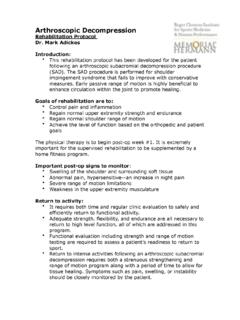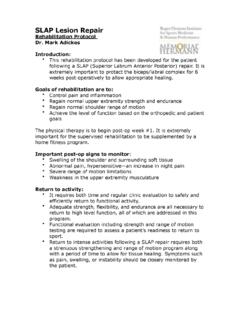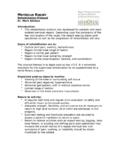Transcription of PCL Reconstruction Rehabilitation Protocol
1 PCL Reconstruction Rehabilitation Protocol Dr. Mark Adickes Introduction: This Rehabilitation Protocol has been developed for the patient who has posterior cruciate ligament (PCL) Reconstruction . The PCL Reconstruction Rehabilitation is unique in that extreme knee flexion places excessive stress on the newly reconstructed PCL. Several activities should be avoided early post-operatively, for best results, avoid: o Isolated active hamstring contraction o Open chain active knee extension from a starting point beyond 70 of flexion o Knee extension from 70-0 is allowed with adequate strength.
2 FROM extension is started at 6 weeks post-op o Flexion should be gained with passive wall slides to avoid active hamstring contraction Goals of Rehabilitation are to: Control joint pain, swelling, hemarthrosis Regain normal knee range of motion Regain a normal gait pattern Regain normal lower extremity strength Regain normal proprioception, balance, and coordination The physical therapy is to begin post-op day #1. It is extremely important for the supervised Rehabilitation to be supplemented by a home fitness program. Important post-op signs to monitor: Swelling of the knee or surrounding soft tissue Abnormal pain response, hypersensitive Abnormal gait pattern, with or without assistive device Limited range of motion Weakness in the lower extremity musculature Return to activity: It requires both time and regular clinic evaluation to safely and efficiently return to functional activity.
3 Adequate strength, flexibility, and endurance are all necessary to return to high level function, all of which are addressed in this program. Isokinetic testing and functional evaluation are required to assess a patient's readiness to return to sport. Dr. Mark Adickes Phase 1: Week 1-2. Range of Motion: Passive, 0-30 . Patella mobs Ankle pumps Gastroc/soleus stretching Strength: Quad sets with e-stim/biofeedback Active knee extension (30-0 ). SLR (flex, abd, add). Weight Bearing: WBAT with 2 crutches and brace Brace: Limited from 0-30 . Modalities: E-stim/biofeedback as needed Ice 15-20 minutes Goals for Phase 1: ROM 0-30.
4 Control pain, inflammation, and effusion Independent in HEP. Adequate quad/VMO control WBAT with crutches and brace as noted by Dr. Adickes Dr. Mark Adickes Phase 2: Week 3-6. Range of Motion: Passive, 0-90 (wk 3-4). o 0-110 (wk 5-6). Patella mobs Ankle pumps Initiate light hamsting stretch Gastroc/soleus/ITB stretch Wall slides to reach goal Strength: Quad sets with biofeedback SLR (flex, abd, add) with weight/tubing Multi-angle isometrics (70-0 ). Knee extension (70-0 ). Initiate mini-squats (0-30 ). Initiate leg press/total gym (0-60 ). Multi-hip in 4 directions Heel raise/Toe raise Wall squats (0-30 ).
5 Balance Training: Weight shift (side-to-side, fwd/bkwd). Single leg balance work Hesitation/Cup walking Steam boats balance work Bicycle: May begin when 110 flexion is reached Weight Bearing: FWB with/without crutches as strength allows Brace: Continue with brace, unlocked to 90 . Modalities: E-stim/biofeedback as needed Ice 15-20 minutes Goals for Phase 2: ROM 0-110 . WBAT to FWB. Control pain, inflammation, and effusion Increase lower extremity strength Enhance proprioception, balance, and coordination Dr. Mark Adickes Phase 3: Week 6-12. Range of Motion: Passive, 0-135.
6 Patella mobs Hamstring/ITB stretch Gastroc/Soleus stretch Wall slides to reach goal Strength: Continue with all strengthening activities from above phases Initiate lateral/fwd step-ups/downs Initiate knee extension 90-0 . Bike/EFX for endurance Reverse lunges-knee not to migrate over toe Smith press squats at wk 8. Balance Training: Single leg balance with plyotoss Wobble board balance activities Foam roller balance activities Sportscord balance/agility work Brace: Discharge post-op brace at week 6. Functional brace to be fitted Modalities: Ice 15-20 minutes Goals for Phase 3: ROM 0-135.
7 Increase lower extremity strength and endurance Control pain, inflammation, and effusion Maximize, proprioception, balance, and coordination Dr. Mark Adickes Phase 4: Week 13-36. Range of Motion: Continue with all stretching activities Strength: Continue with all strengthening activities increasing all weight and repetitions Progress with all single leg activity Balance Training: Continue with advanced balance/agility training Single leg work on advanced surfaces Running Program: Initiate running on minitramp and progress to treadmill as tolerated Backward walking on treadmill Aerobic Conditioning: Walking program Swimming program (kicking).
8 Bike for strength and endurance EFX for strength and endurance Functional Training: Lateral movements (slide board, shuffles). Initiate light plyometrics/agility drills High speed training Initiate sport specific training Carioca, figure 8's Modalities: Ice 15-20 minutes Goals for Phase 4: Maximize lower extremity strength and endurance Return to previous activity level Return to specific functional level







